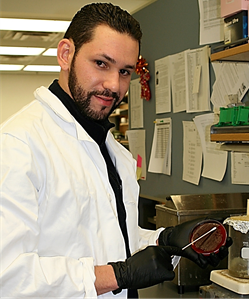
Christian Gonzalez, Ph.D.
Department: Microbiology & Immunology, 2013
Faculty Mentor: Timothy Cover, M.D.
Dissertation Title: Structure and Function of the Helicobacter pylori VacA p33 Domain
Dissertation Abstract: Helicobacter pylori colonizes the human stomach and is associated with an increased risk of peptic ulcer disease, gastric adenocarcinoma, and gastric lymphoma. An important virulence factor produced by Helicobacter pylori is the secreted pore-forming toxin known as VacA. The 88 kDa secreted VacA toxin is comprised of two domains, designated p33 and p55. The overarching objective of my thesis work was to analyze the structure and function of the VacA p33 domain. I successfully purified a recombinant form of the p33 domain, showed that it physically interacted with the p55 domain to form complexes, and demonstrated that toxin activity could be reconstituted by mixing the p33 and p55 domains. Electron microscopy of p33/p55 complexes revealed small rod-shaped structures that converted to oligomeric flower-shaped structures in the presence of detergent. I investigated functional properties attributable to the p33 i-region, and showed that polymorphisms in this region were associated with variations in the ability of VacA to cause alterations in human T cells. An increased activity of type i1 forms of VacA compared to type i2 forms of VacA was attributable to differential cell-binding properties of these proteins. Finally, I successfully crystallized an 88 kDa VacA protein secreted by H. pylori and demonstrated that it is comprised of predominantly β-helical elements. Taken together, my work has demonstrated the importance of the p33 domain in VacA activity, and has provided new insights into the structure of the p33 domain.
